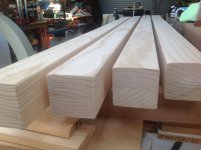sofa_king_rad
Member
- Joined
- Mar 26, 2016
- Messages
- 100
prepping for my first couple projects. many of the Plans I'm finding are using plywood and 4x4's that they cut down. Some i've seen are even using standard pine from somewhere like Home Depot.
That doesn't seem right to me. I'm still learning about wood and how to buy it, how it is sold. The hardwood dealer i found pretty much everything was 1 by .... Probably a proper term for this. So is it common to glue your own posts for or spend the money and order bigger size?
That doesn't seem right to me. I'm still learning about wood and how to buy it, how it is sold. The hardwood dealer i found pretty much everything was 1 by .... Probably a proper term for this. So is it common to glue your own posts for or spend the money and order bigger size?

